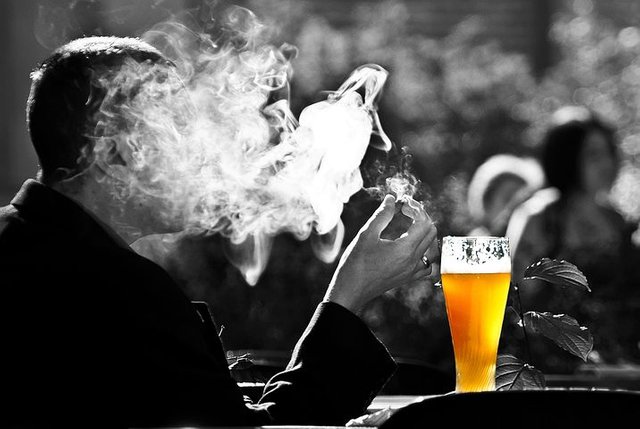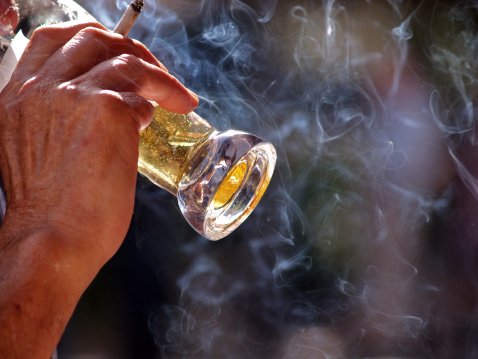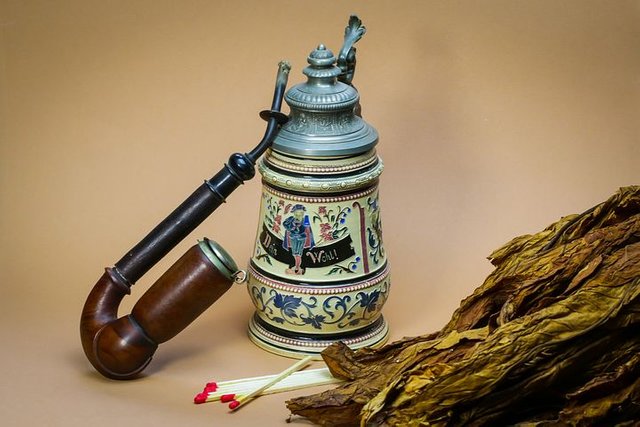BEVERAGES AND TOBACCO
#Steem
Non-Alcoholic Beverages
Non-alcoholic beverages include tea, coffee and cocoa. Tea and coffee have no food value unless taken with milk and sugar. Cocoa is considered to have food value because of its fat content.
TEA
Tea is a drink made by infusing the dried leaves of the tea plant which grows chiefly in India, Ceylon and China. It contains:
- Theine which is very soluble and when the leaves are infused it is practically all dissolved within 3 minutes. It gives tea its stimulating properties for it is a drug which acts in small doses as a stimulant of the nervous system but when taken in excess it produces nervousness, heart palpitation and digestive disturbances.
- Tannin which is bitter and astringent and is very liable to upset digestion. It is much less soluble than theine; consequently, in order to secure in the tea the benefits of the theine without the disadvantages of the tannin it should not be allowed to last for more than four minutes in the tea-pot or kettle.

Preparation of tea: A good plan is to pour the tea, after four minutes infusion of the tea leaves with water which has just come to the boil, into another warmed tea-pot in which the tea can be kept hot for as long as may be desired. Taking milk in tea is desirable as it precipitates some of the
tannin.
Effects of tea are
- It is a stimulant.
- Water free from disease organisms is taken into the body.
- It has a cooling effect when the body is hot for the sweat generated evaporates with heat.
- It has a warming effect when the body is cool.
COFFEE
Coffee originally came from Arabia but the plant is now cultivated in most tropical countries including West African countries. Coffee is a drink made by percolating boiling water over roasted and ground coffee beans. The most important content is caffeine. Caffeine is similar to theine removing the feeling of fatigue. in tea, but more potent. It acts as a stimulant of the nervous system by
Effects of coffee are
- Coffee, if taken frequently at night, prevents sleep (owing to the fact the synapses more easily). that the caffeine acts by enabling nervous impulses to break through
- Taken in excess it acts injuriously on the nervous, circulatory and
digestive systems. - Neither tea nor coffee is food. They have stimulating effects by removing the feeling of fatigue. (Exhaustion remains).
- It helps in the treatment of shock. 4. Strong coffee counteracts some of the poisonous effects of alcohol.
COCOA
Cocoa is grown mainly in West Africa and Brazil. Cocoa is made from its seeds. It contains an alkaloid called theobromine which is similar to theine and caffeine in its stimulating effects. Cocoa differs from tea and coffee in containing a large amount of fat. So cocoa is food as well as a stimulant. Its use should be encouraged among the young in place of tea or coffee. Its by-products like chocolate, Ovaltine and Bournvita are good
for children, the invalid and the aged.
Effects of cocoa are
- It has a large nutritive value.
- It stimulates but on a lower scale than tea or coffee.
- Most of its by-products such as chocolate, Bournvita or Ovaltine are food having such things as eggs, wheat and milk added to them. NOTE: Tea and coffee should only be given in very limited amounts to children and even then it should be well diluted. Milk or cocoa made with milk is much more suitable for children, pregnant women, the invalid and the aged.

Alcoholic Beverages
Alcohol is a liquid generated by the fermentation of sugar and forms the intoxicating element of fermented liquors. Pure alcohol is colourless and looks like water but it has a peculiar smell; unlike water it has not the power to quench thirst. It will burn if it is pure.
FACTS ABOUT ALCOHOL-THE REPORT OF THE ROYAL COMMISSION ON LICENSING 1931
- Alcohol is primarily a drug acting directly on the nervous centres of the brain.
- The action of alcohol is essentially narcotic and not stimulant.
- Alcohol taken in excess may exert like any other drug poison actions, and if taken habitually in excess may cause or contribute to a variety of diseases.
- Alcohol has a certain food or fuel value, the scope of which however, is strictly circumscribed by the disadvantages of its drug action.
- The drug or poison action of alcohol is substantially restricted when alcohol is taken in a diluted solution or with food.
- The use of alcohol as an aid to work whether physically or mentally is physiologically unsound.
- Alcohol has no direct curative or prophylactic properties although within a strictly limited range of condition it has a certain therapeutic value.
BEER
Constituents of beer are water, alcohol, dextro-glucose and hop extracts. Beer is made by fermenting the starch from barley with the addition of hop. It contains about 3-6 percent alcohol.
The nutritive value of beer is due to its sugar and yeast content. Taking too much beer makes people drowsy. A person can finish a bottle of beer without being intoxicated. It has a stimulating effect. It is intoxicating
when taken in excess.
WINE
Constituents of wine are water and alcohol. Wine is produced by the fermentation of sugar in the juice of the grape. Wine is produced by the Wine contains from 9-22 percent alcohol. Palm wine from the oil palm tree or raffia palm tree or coconut tree is essentially a juice which becomes alcoholic when left for some hours during which fermentation takes place.
SPIRITS
Constituents are water, alcohol and aromatic bodies which give them their characteristic taste and value. Spirits are produced by distilling fermented liquors, e.g., whisky is produced by distilling malted barley. It has no significant nutritive value. Effects are due to the presence of alcohol.
FOOD AND MEDICAL VALUE OF ALCOHOL
Alcohol is utilised by the body as a fuel. It cannot however be altered or stored by the body for future requirements, but circulates in the blood for some 15-24 hours, during which period it is very slowly burnt. For practical everyday purposes, alcoholic beverages cannot be regarded from a health point of view as a source of nourishment.
Alcohol has a therapeutic value but not a curative or preventive value. It is used by doctors as a sedative in order to relieve pain.
EFFECTS OF TAKING ALCOHOL ON THE INDIVIDUAL AND THE SOCIETY The bad effects of alcohol are
- Alcohol dulls the brain and weakens the nervous system. Contrary to popular opinion, the effect of alcohol on the nervous system is to depress rather than stimulate its functions. Self-criticism is blunted. Drinkers lose the power of sound judgement and self-control, become quarrelsome, argumentative and talkative because the brain is dull. 2. Drunkards have reduced capacity for work. The habitual drinking of beer, wine and spirits, may tend to weaken the heart muscles and the body generally and to diminish the power and capacity for work. 3. A habitual drinker has reduced resistance to disease. A person who habitually drinks alcoholic drinks to excess is more likely to contract illness than one who does not. The devitalising of the tissues produced by chronic alcoholic poisoning lowers the defences of the body against the invasion of germs and consequently the body is rendered more pneumonia, tuberculosis and septicaemia. liable to develop diseases dependent on microbial invasion such as pneumonia, tuberculosis and septicemia.
- Alcohol weakens the digestive system. It not only increases the flow of gastric fluid but also modifies its composition and reduces the quantity of the digestive ferment, pepsin. Too much alcohol leads to chronic inflammation of the stomach, the intestine and the liver.
- It lowers the temperature of the body. Alcohol is sometimes taken to relieve a feeling of cold; physiologically such a practice is quite wrong since alcohol has an action on the heat regulating centre causing it to dilate the superficial cutaneous blood vessels and so divert more blood to the skin thereby producing a feeling of warmth by raising the temperature. The great heat is given out by the skin with the result that the body temperature as a whole is reduced hence the body becomes susceptible to pneumonia.
Effects of continued indulgence are
- Modification of the character of the individual. The general intelli- gence, the will-power, the understanding, the ability to think and reason clearly are injured and weakened. Thus mental activity generally is reduced and the work that is done becomes increasingly inaccurate, careless and untrustworthy.
- Continued indulgence has a strong tendency to render active some forms of insanity that might otherwise have remained latent and unsuspected.
Social effects are - Immorality.
- High mortality. The mortality among the manufacturers and sellers of alcoholic beverages is high due to diseases attributed to alcoholism. 3. Poverty. Intemperance is largely a contributory factor to many cases of poverty and in the families where there is only just enough income to provide for the bare necessities of life, money spent on drinks must of necessity mean deprivation somewhere and only too often in the quality of food.
PREVENTION OF THE EVILS ARISING FROM ALCOHOLISM
Remedy for the evils arising from alcoholism rests partly with the State and partly with the individual. The State imposes restrictions: 1. By law on the sale of drinks.
- By increasing the price of alcoholic beverages.
- By curtailing the hours during which alcoholic drinks can be purchased. 4. By the improvement in social conditions such as the steady demolition of slum property and provision of better housing accommodation, the development of the cinema and broadcasting, the increased facilities for outdoor recreation and general educational development affecting particularly young people including specific instruction in the subject
of hygiene and temperance.
The State should give somewhat more favourable terms to total abstainers as it has been recognised that such persons are on the whole likely to live longer than non-abstainers.
The individual should contribute in the following way:
- Form a habit of not spending much time in public houses where alcoholic beverages are sold.
- The individual should have healthy attractive surroundings and should divert his interest to other things and there should be less indulgence in alcoholic beverages.
CONDITIONS UNDER WHICH ALCOHOLIC BEVERAGE SHOULD BE TAKEN
- Adults should not take more than 2 fluid oz (60 millilitres) a day. 2. It should be taken with food and in diluted form.
- As medicine it could be used as a sedative.
- It must under no circumstance be given to children or pregnant
women.
Tobacco
Tobacco is made from the leaves of a species of a plant called Nicotiania
tabacum.

EFFECTS OF TOBACCO
- Tobacco contains nicotine and carbon monoxide, both of which are mild poisons in small doses and deadly poisons in larger doses. Under ordinary conditions a few smokes a day do not appear to have any harmful effect. As the dosage increases and more of the poisonous products become absorbed certain symptoms of which the most common is the smoker's cough begin to appear.
- The appetite falls off and the senses of taste and smell become blunted. 3. It could bring about a loss of physical efficiency and power of memory. 4. It increases the rate of the heart beat and causes it to beat irregularly and sometimes to miss a beat.
- It causes tobacco amblyopia by poisoning the nerve cells in the retina. thereby causing a serious loss of vision.
The Royal College of Physicians has confirmed that a cause of death due to lung cancer is excessive smoking. Those who take about thirty smokes a day are prone to the disease.
#steemacademy
#steemhealth
Hi, @orange2
Follow these steps to get yourself verified in the community.
Make sure you add a verification picture in your introduction post
What is Verification Picture:
Take a selfie while holding a page written Beauty of Creativity with the date and your Steemit username
for more information join us on Discord